I’m a Bahamas addict. I can’t even imagine life without at least a few crossings there each season with my boat, MARC VI. This has been a tradition for more years (ok, make that decades) then I care to remember! And my trip to Cape Eleuthera’s Powell Pointe Marina this past June was a prime example of why Bahamas Fever is in my blood for good.
Cape Eleuthera is a ways out there, for a mid size boat. But the proverbial dangling carrot for owners of such craft – myself especially - is the relatively light fishing pressure, access to deep water (depths exceeding 4,000 feet are just two miles off the beach along some points), incredible structure with the likes of The Bridge and Tommy Pointe, and - as we were about to find out – incredible reef- and offshore fishing. Toss in posh accommodations and an expansive deep water marina at the Powell Pointe complex, and this is fishing heaven.
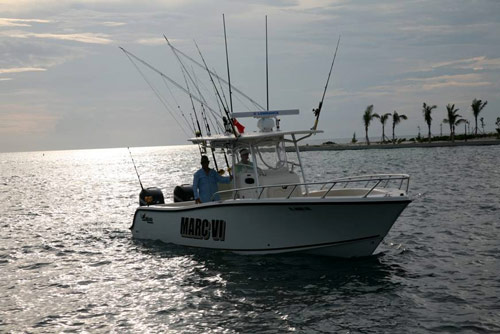
I first sampled the fishing here two springs ago, aboard friend Barry O’Neill’s 54-foot Hatteras, Buffer Zone. Barry and sons Danny and Robbie are long-time Bahamas big game anglers who spend each spring and summer chasing fish throughout the Islands. The O’Neill’s selected Cape Eleuthera that season because of its remoteness. What really stood out to me, however, was that these waters, on the Exuma Sound side, are on the lee of any hard easterly breezes; It was blowing 30-knots due East during my trip with the O’Neill’s, yet we were able to troll the drop off in 1,000 feet of water in only a two- to three–foot sea, and bottom fish in 65 feet of water in a nearly slick ocean.
Given the geographical layout of Cape Eleuthera, and the often persistent easterly breezes which accompany the prime spring fishing here, I was sold on it as a great destination for mid-size boats, like mine. How many places in the Bahamas can you troll or bottom fish when the wind is cranking from the northeast, east, or east/southeast, and not really be shut out? I was coming back next season with my boat.
ONE WAY RECORD - Like all Bahamas crossings, when you’re mapping out routes at your office desk and sipping hot coffee, they look so exciting and simple to do! This one, however, would be a biggie – my longest one-way venture into the Bahamas to date aboard my 28-foot, twin outboard-powered center console.
The plan was to leave North Miami’s Haulover Inlet and travel 54-miles to Bimini, where we’d clear Customs and Immigration and top off with fuel. From there, we’d cruise some 72 miles across the Bank to the deep Tongue of The Ocean, where we’d steer toward Nassau Harbour for about a 57 mile run. We’d cut through Nassau Harbour, get on the Yellow Bank and run 38 miles to the tip of Ship Channel Cay, where we’d cut across to Exuma Sound and run the last 29 miles to Cape Eleuthera’s Powell Pointe Marina. That’s a 250-mile, one-way run!
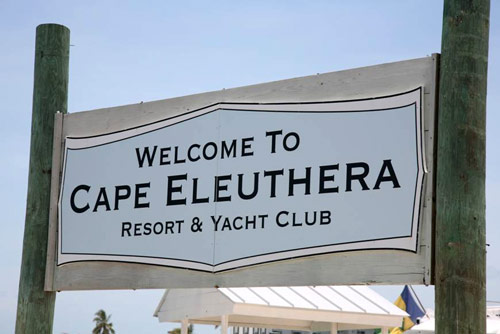
Joining me was friend Harry Vernon III. Harry and I planned on trolling offshore for two days and then bottom fishing a couple days, all while shooting an episode for my ESPN2 show. What continues to intrigue me when we’re Bahamas-bound is how my boat still floats with a week’s worth of gear, the likes of 20 rod and reel combinations, several large tackle boxes, lure bags, chum (40 seven pound blocks), dozens of fresh trolling baits, food, drinks, ice, production gear, personal bags, etc., etc., etc.; Somehow it always does, and we were off once again to the Bahamas!
WHOLE LOTTA SHAKING GOING ON - As luck would have it, our “departure” wind was from the East at 20-knots. We cleared an agitated Haulover Inlet and entered a rough ocean. A “normal” crossing from Miami to Bimini typically takes us around 90-minutes, yet this one took us exactly three hours! Add two more hours clearing Customs and topping off with fuel, and it was high noon when we left Bimini.
The winds came down some on the backside of Bimini, perhaps to around 15-knots, enabling us to make up some time on the Bank and enroute to Nassau. Just to be sure I had enough fuel to complete the journey, I took on 50 gallons in Nassau. We pulled into Cape Eleuthera’s Powell Pointe Marina at 8:30 p.m.! Talk about a long day – but at least we made it in a day!
By comparison, and a tribute to how easily a mid-size, outboard-powered boat can do this trip in good weather, we left for home at 12:15 on a stifling hot, windless afternoon, and - including the 40-minutes it took to top off with fuel in Nassau - cleared Haulover Inlet at 7:30 p.m.! Needless to say, we were booking hard across that flat ocean!
IT’S MARLIN TIME AGAIN – “The Bridge” is an impressive reef system connecting Eleuthera Point to Little San Salvador. It divides the Atlantic Ocean and Exuma Sound for the nine miles between the two Islands. From Powell Pointe Marina, it’s about a 20 mile run down to Eleuthera Point and The Bridge. This is blue marlin country, given this structure and sharply descending bottom on both sides, mixing of currents and bait accumulations. Peak blue marlin season here is April, May and June, although blues have been caught virtually every month of the year off Cape Eleuthera. Dolphin migrate thickest in April and May, with decent fishing through mid June.
FIRST ROUND KNOCKOUT! - Harry and I left Powell Pointe Marina at 10:00 a.m. the morning after our crossing, in search of a blue marlin. Given our late start, we ran right out front into 1,000 feet of water and dispatched a spread of lures, naked and Ilander-tipped ballyhoo, a splashing mackerel and a large Yo-Zuri Bonita lure. For teasers, we deployed a squid spreader bar and a large hookless marlin lure, and two 96-fish StripTeaser dredges (one off each transom corner). The water behind the MARC VI was lit up like a Christmas tree!
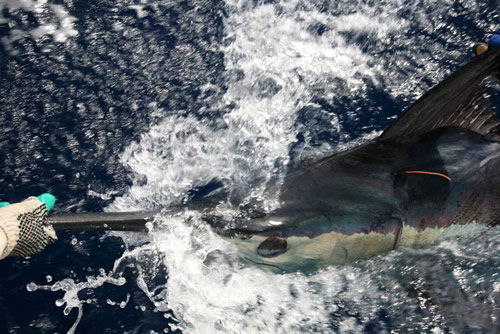
We settled into a broad Zig-Zag pattern in the direction of The Bridge, in as shallow as 1,000 feet and out beyond 4,000 feet (a gap of less than a mile). Right out front of nearby Davis Harbour, and around 11:00 a.m., a blue marlin raced up to a lure on Harry’s side. It struck the lure, but missed the hook. It then dropped back and took a shot at the long outrigger bait - a ballyhoo/Ilander combo. Harry didn’t connect. The blue charged over to my long outrigger bait - a naked horse ballyhoo - and piled on it! I was hooked up!
One advantage of running two teasers and two dredges and seven or eight trolling baits is that – in unison - they create a lot of visual excitement; I’m sure we raise more fish because of this set-up. However, the disadvantage is that - once you hook a marlin or other large fish - they all have to be brought in! This is a feat-and-a-half with just two men aboard – especially when one is fighting a fish - but Harry and I eventually got the job done!
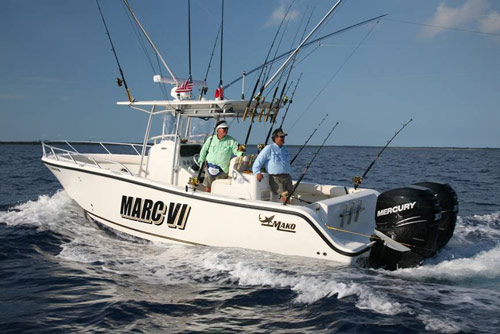
The blue, hooked on 50-pound class tackle, never jumped. Rather, it made a few strong and long runs before deciding to slug it out deep. Harry kept the MARC VI barely moving forward, with just one outboard in gear; He’d shift into neutral when we reached a stalemate, and into gear once I was reclaiming line. The wind-on leader soon came into view, followed by a totally lit up blue marlin! I cranked the 20-foot long wind-on leader onto the reel, pumping the fish closer to the surface. The ball bearing snap swivel and10-foot long main leader followed, and Harry wired the fish.
The boat side marlin, still full of energy and kicking up a ton of white water, gave Harry just about all he could handle, including a bruised elbow and some black and blue forearms! Yet, Harry valiantly contained the marlin long enough for us to pluck the hook from its bill and turn it loose! One blue marlin release during the first hour of the trip! Think we were stoked?!
We stayed on the troll and religiously studied the radar for birds - which we’d steer for, and any prominent bottom structure. We eventually made it down to The Bridge. Harry and I picked off a couple 20- to 25-pound dolphin, and wrapped up day one in grand fashion.
BRIDGE OVER BLUE WATERS - Day two found us down at The Bridge, trolling and searching out deep structure, floating debris, weeds, bait, water surface temperature variations, and birds on the radar - on both the Atlantic and Exuma Sound sides. Tight to The Bridge on the Exuma Sound side, where the bottom shot up nearly instantly from over 1,000 feet to a couple hundred feet or so, we found hundreds of tiny skipjacks and pockets of flying fish and, of course, barracuda!
We worked in tight to The Bridge and then out a 1/4-mile or so into very deep water. Sure enough, a blue marlin came up behind my short outrigger bait – an Ilander-tipped ballyhoo. It knocked it from the clip, and I freespooled the bait until I felt the marlin swim off with it. I advanced the drag and set the hook; We were on again!
After a long run, the fish settled down and I began to take back line. Then, the hook pulled! Ouch! Talk about having a trophy snatched right out of your hands. Dejected, Harry and I kept on the troll. There’d be no other marlin that day, but we did score more dolphin to 35-pounds.
HAPPY HOUR TUNA - Late each afternoon, beginning around 5:00 p.m. – and closer to Powell Pointe and Tommy Pointe – the tuna showed. We’d mark a cluster of birds on the radar, and run to them. Sure enough, dozens of birds and breaking fish put us in a sushi state of mind! Most were juvenile tuna, but we knew some big ones had to be somewhere in the mix.
We first trolled the fringes of the schools, pulling small- and medium naked ballyhoo on 80- and 100-pound test fluorocarbon leaders. Harry hooked a beauty of a yellowfin on a 30-pound class outfit, only to lose it to a large shark! These waters, incidentally, hold some incredibly big sharks; Each afternoon, while stalking tuna, we’d see two or three huge tiger sharks at the surface, obviously staying close to their food supply!
Our trolling efforts fell short, as did chunking. We eventually gave in to the small tuna by pitching Yo-Zuri Live Bait Minnow Jigs along the fringes of the school, letting the lures sink 20 feet or so and then steadily and rapidly retrieving them. Harry and I hooked up instantly with five- to 10-pound class yellowfins.
BOTTOMS UP! – Tommy Pointe, roughly 9-miles west/northwest of Powell Pointe, is a section of reef extending outward into deep Exuma Sound. The reef here is mostly 20- to 40-feet deep, and its narrow 50- to 60-foot deep outer fringes give way nearly instantly to 1,000-plus foot depths; One can’t help but imagine the monsters which patrol these deep walls!
After marking some great looking bottom in 55 feet, we anchored and hung over a block of Captain Mark’s Sardine Chum. I began to ready our yellowtail tackle when Harry laughed and summoned me to the cockpit. He pointed at the chum bag, and the dozens of yellowtail already at the surface. What’s more, a half-dozen of them were eating the chum right from the bag!
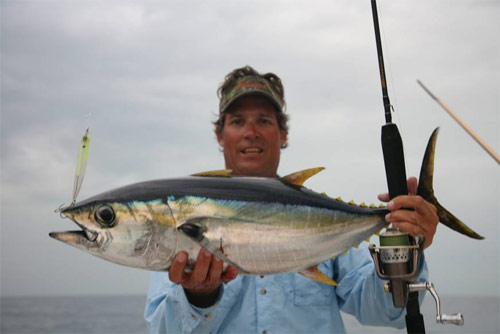
Within 15 minutes, the yellowtail were as thick as ants on spilled syrup, and catching them was embarrassingly elementary: just drop in a silverside by the chum bag and lift out a yellowtail! We had to make this more challenging!
We decided to switch over to the Yo-Zuri Live Bait Minnow Jigs, the ones the yellowfin tuna couldn’t resist. Harry was first to cast a jig into the chum slick, and a big ‘tail ate it while it was sinking! I thought he got lucky, but Harry kept catching big yellowtails on the jig. I pitched mine out and did the same! Whereas the one- and two-pound ‘tails devoured our natural baits, the jigs enabled us to cull out bigger fish.
We maintained our chumming strategy and had the tails as far back and up as thick as I’ve ever seen – anywhere! We’d shoot out a couple ladles of our chum supplement, and then load our Chum King with cut up sardines, lower it 30 feet and disperse the chunks. Within minutes, we’d rally schools of Cero mackerel, horse eye jacks, huge blue runners and even a school of angelfish! We were fishing in a virtual aquarium!
On one of the Chum King drops, an 80-plus pound amberjack suddenly appeared and gobbled up all the sardine chunks. I grabbed a 50-pound class stand up outfit we had rigged for chunking tuna, impaled a sardine on its hook and freelined it down. The AJ noticed and turned, but a Cero mackerel rushed in and ate the sardine. I cranked in the Cero, removed it from the hook, and then impaled it onto the hook: It was going back as bait! The AJ slurped it right up, and I immediately put the heat to the fish. I was I had a better ending, but that big fish just smoked me, cutting the line on bottom when it ran off the edge of the reef.
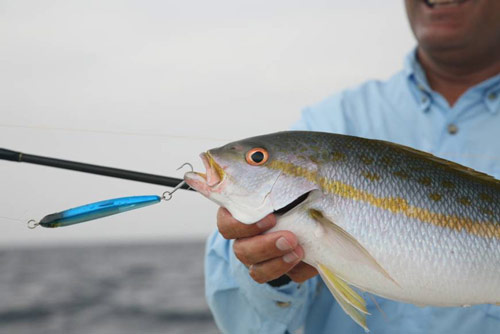
I couldn’t have been more pleased by my decision to make that long run to Cape Eleuthera’s Powell Pointe Marina. To date, it’s my longest one-way run into the Bahamas with my boat. The fishing here is awesome, with more yellowtails than I’ve seen anywhere, and great offshore action. And as this trip proves, it isn’t really that bad of a hike, especially with good weather.
I have to get back here this coming season, perhaps in May when the dolphin are solid. The blues will be here in good numbers too, and I’ll keep a sharp eye out for those tuna late in the afternoons. I’d love to spend four or five days strictly on the troll. But that might be difficult, knowing how alive the reefs are. Decisions! Decisions! But not to worry; somehow I’ll work through this! I usually do.
The Tackle Box:
Offshore Trolling:
Rods: Penn International V Stand-Up rods (6’),
model: VS5010 AWA60 – rated for
50 to 100-pound test lines.
Line: Sufix Superior Hi-Vis Yellow, 50 and 80-pound test.
Leaders: WIND-ON: 150-pound test Sufix Superior monofilament.
MAIN: 300-pound test Sufix InvisiLine Fluorocarbon;
Stainless leader wire, 93-lb. test, for some Ilander/ballyhoo rigs.
Stainless Steel 49-strand cable, 480-lb. test, for Yo-Zuri Bonita.
Swivels: Krok ball bearing snap swivels, # 7 (200 lb. test)
Hooks: For ballyhoo: Mustad 7731-D; Sizes: 9/0, 10/0, 11/0
Teasers: (From outriggers):
MoldCraft 9” Squid Spreader Bar
Bost Americano, Large - 16” hookless lure
(From each transom cleat):
StripTeaser 6 arm collapsible dredge with
96 StripTeaser holographic fish.
YELLOWTAIL:
Reels: Penn AF 3000, spin
Rods: Penn Torque Jigging Series, model: TJ2050S70,
a 7’ rod rated for 20- to 50-pound test lines.
Line: Sufix Performance Braid, 20-pound test.
Leader: Sufix InvisiLine Fluorocarbon, 30-pound test.
Lure: Yo-Zuri Live Bait Minnow Jig, 4”
Chum: Captain Mark’s Pure Sardine Chum
CASTING FOR YELLOWFIN TUNA:
Same as for yellowtail, minus the chum.
THE PLACE TO STAY
Powell Pointe at Cape Eleuthera is a remarkably beautiful and modern facility with all the amenities one would expect to find at such an acclaimed Resort – and then some. It’s situated on a 4,500 acre private beach preserve.
The marina has both gas and diesel - and ice. It is the largest and deepest marina in the Bahamas Out Islands, with remarkably clear water (you can see sharks and stingrays swimming along the bottom, especially at night!). It’s a popular destination for luxury yachts.
There’s a dive, snorkel and excursion center for those who prefer getting into the water, as well as an Out Island Outfitters rental center and provisions store. Breakfast and lunch can be had at the Bahama Coffee Company deli and bakery, while dinner is always an option at Barracuda’s Beach Bar and Grill.
Lavishly-appointed waterfront homes with patios and decks and panoramic ocean views round out the facility.
For more information, visit: www.capeeleuthera.com , email: info@capeeleuthera.com, or call 242-334-8500.


.jpg)